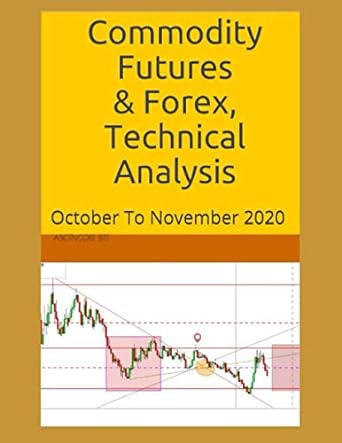Answered step by step
Verified Expert Solution
Question
1 Approved Answer
updated Slide #1: Key Attributes of FFF's Current Collection System (Eastern Region, Last Year's Data) 1. Our eastern region customers, stores that sell our retro-style
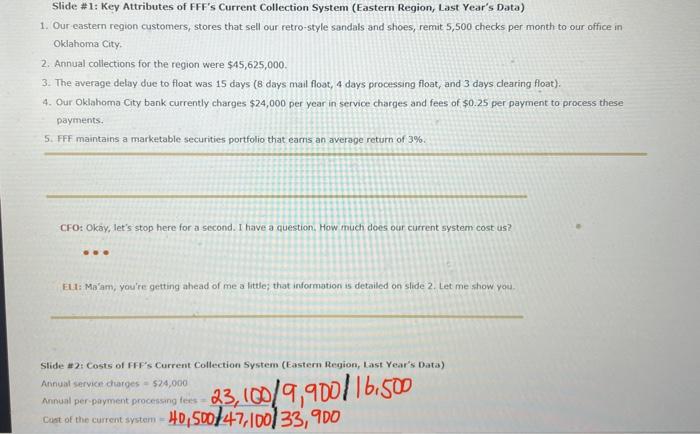

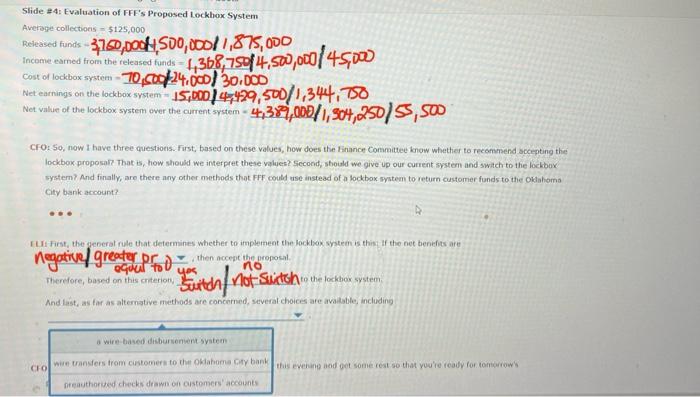
updated 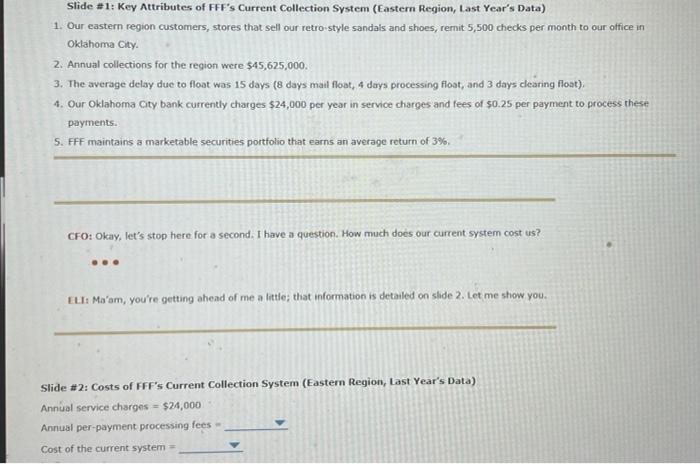
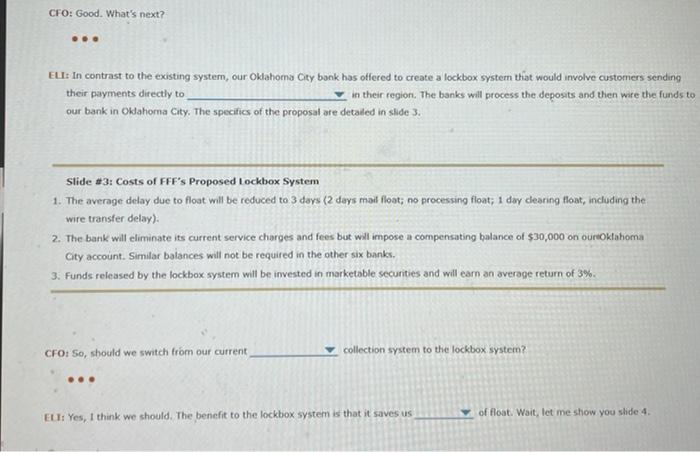
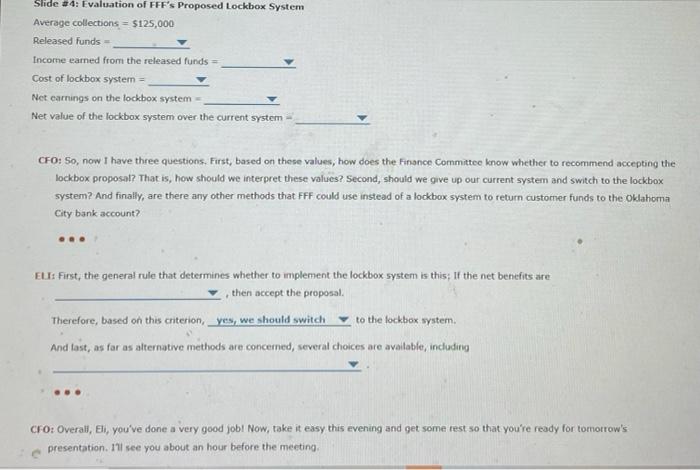
Slide #1: Key Attributes of FFF's Current Collection System (Eastern Region, Last Year's Data) 1. Our eastern region customers, stores that sell our retro-style sandals and shoes, remit 5,500 checks per month to our office in Oklahoma City 2. Annual collections for the region were $45,625,000. 3. The average delay due to float was 15 days (8 days mail float, 4 days processing float, and 3 days clearing float). 4. Our Oklahoma City bank currently charges $24,000 per year in service charges and fees of $0.25 per payment to process these payments. 5. FFF maintains a marketable securities portfolio that eams an average return of 3%. CFO: Okay, let's stop here for a second. I have a question. How much does our current system cost us? .. EL.: Ma'am, you're getting ahead of me a little; that information is detailed on slide 2. Let me show you Slide #2: Costs of FFF's Current Collection System (Eastern Region, Last Year's Data) Annual Service charges = 524,000 Annual per payment processing Cunt of the current system 10/9,900/16.500 40,500247100) 33,900 CFO: Good. What's next? ELL: In contrast to the existing system, our Oklahoma City bank has offered to create a lockbox system that would involve customers sending their payments directly to in their region. The banks will process the deposits and then wire the funds to our bank in Oklahoma City pre detailed in slide 3. the company's branch office a designated bank account Slide #3: Costs of FFF's designated post office box 1. The average delay due to float will be reduced to 3 days (2 days mil float nio processing float; 1 day clearing float, including the wire transfer delay). 2. The bank will eliminate its current service charges and fees but will impose a compensating balance of $30,000 on our oklahoma City account. Similar balances will not be required in the other sex banks. 3. Funds released by the lockbox system will be invested in marketable securities and will earn an average return of 3% a centralized or CFO: So, should we switch from our current collection system to the lockbox system? decentralized Yes, I think we should. The benefit to the lockbox system is that it saves us bila (2 float will let me show you slide 4 Slide 24: Evaluation of FFE's Proposed Lockhox System Average collections - $125,000 Income earned from the released funds Released funds - 370,000f|500,000/1,875,000 4368,75084,500,000/45,00 Cost of lockbox system - 70.500 24.000) 30.000 Net earnings on the lockbox system - 15,00014,429,500/1,344,750 Net value of the lockbox system over the current system - 4,381,000/1,504,250155, 500 CFO: So, now I have three questions. First, based on these values, how does the Finance Committee know whether to recommend accepting the lockbox proposal? That is, how should we interpret these values? Second should we give up our current system and switch to the lockbox system? And finally, are there any other methods thot Frr could use instead of a tockbox system to return customer funds to the Oktohoma City bank account? First, the general rule that determine whether to implement the lockbox system is this if the net benefits are negative great for them acope the oropoun. no you Therefore, based on this criterion to the lockbox system een toch niet-Suitch And last, as far as alternative methods are concerned, Several choices are available, including wire-based disbursenent system wire transfers from customers to the Oklahoma y bank this evening dodot some rest so that you're ready for tomorrow CHO reauthored checks drawn of customers' accounts Slide #1: Key Attributes of FFF's Current Collection System (Eastern Region, Last Year's Data) 1. Our eastern region customers, stores that sell our retro style sandals and shoes, remit 5,500 checks per month to our office in Oklahoma City. 2. Annual collections for the region were $45,625,000. 3. The average delay due to float was 15 days (8 days mall float, 4 days processing float, and 3 days clearing float). 4. Our Oklahoma City bank currently charges $24,000 per year in service charges and fees of $0.25 per payment to process these payments. S. FFF maintains a marketable securities portfolio that earns an average return of 3% CFO: Okay, let's stop here for a second. I have a question. How much does our current system cost us? ELI: Ma'am, you're getting ahead of me a little; that information is detailed on slide 2. Let me show you Slide #2: Costs of FFF's Current Collection System (Eastern Region, Last Year's Data) Annual service charges = $24,000 Annual per-payment processing fees Cost of the current system CFO: Good. What's next? ... ELI: In contrast to the existing system, our Oklahoma City bank has offered to create a lockbox system that would involve customers sending their payments directly to in their region. The banks will process the deposits and then wire the funds to our bank in Oklahoma City. The specifics of the proposal are detailed in slide 3. Slide #3: Costs of FFF's Proposed Lockbox System 1. The average delay due to float will be reduced to 3 days (2 days mal float; no processing float; 1 day clearing float, including the wire transfer delay). 2. The bank will eliminate its current service charges and fees but will impose a compensating balance of $30,000 on ouruoklahoma City account. Similar balances will not be required in the other six banks. 3. Funds released by the lockbox system will be invested in marketable securities and will earn an average return of 3% CFO: So, should we switch from our current collection system to the lockbox system? EU: Yes, I think we should. The benefit to the lockbox system is that it saves us of float. Wait, let me show you slide 4. Slide # 4: Evaluation of FFF's Proposed Lockbox System Average collections = $125,000 Released funds - Income earned from the released funds Cost of lockbox system Net earnings on the lockbox system Net value of the lockbox syster over the current system CFO: So, now I have three questions. First, based on these values, how does the Finance Committee know whether to recommend accepting the lockbox proposal? That is, how should we interpret these values? Second, should we give up our current system and switch to the lockbox system? And finally, are there any other methods that FFF could use instead of a lockbox system to return customer funds to the Oklahoma City bank account? ELI: First, the general rule that determines whether to implement the lockbox system is this: If the net benefits are then accept the proposal Therefore, based on this criterion, yes, we should switch to the lockbox system And tast, as far as alternative methods are concerned, several choices are available, including CFO: Overall, Eli, you've done a very good job! Now, take it easy this evening and get some test so that you're ready for tomorrow's presentation 11 see you about an hour before the meeting Slide #1: Key Attributes of FFF's Current Collection System (Eastern Region, Last Year's Data) 1. Our eastern region customers, stores that sell our retro-style sandals and shoes, remit 5,500 checks per month to our office in Oklahoma City 2. Annual collections for the region were $45,625,000. 3. The average delay due to float was 15 days (8 days mail float, 4 days processing float, and 3 days clearing float). 4. Our Oklahoma City bank currently charges $24,000 per year in service charges and fees of $0.25 per payment to process these payments. 5. FFF maintains a marketable securities portfolio that eams an average return of 3%. CFO: Okay, let's stop here for a second. I have a question. How much does our current system cost us? .. EL.: Ma'am, you're getting ahead of me a little; that information is detailed on slide 2. Let me show you Slide #2: Costs of FFF's Current Collection System (Eastern Region, Last Year's Data) Annual Service charges = 524,000 Annual per payment processing Cunt of the current system 10/9,900/16.500 40,500247100) 33,900 CFO: Good. What's next? ELL: In contrast to the existing system, our Oklahoma City bank has offered to create a lockbox system that would involve customers sending their payments directly to in their region. The banks will process the deposits and then wire the funds to our bank in Oklahoma City pre detailed in slide 3. the company's branch office a designated bank account Slide #3: Costs of FFF's designated post office box 1. The average delay due to float will be reduced to 3 days (2 days mil float nio processing float; 1 day clearing float, including the wire transfer delay). 2. The bank will eliminate its current service charges and fees but will impose a compensating balance of $30,000 on our oklahoma City account. Similar balances will not be required in the other sex banks. 3. Funds released by the lockbox system will be invested in marketable securities and will earn an average return of 3% a centralized or CFO: So, should we switch from our current collection system to the lockbox system? decentralized Yes, I think we should. The benefit to the lockbox system is that it saves us bila (2 float will let me show you slide 4 Slide 24: Evaluation of FFE's Proposed Lockhox System Average collections - $125,000 Income earned from the released funds Released funds - 370,000f|500,000/1,875,000 4368,75084,500,000/45,00 Cost of lockbox system - 70.500 24.000) 30.000 Net earnings on the lockbox system - 15,00014,429,500/1,344,750 Net value of the lockbox system over the current system - 4,381,000/1,504,250155, 500 CFO: So, now I have three questions. First, based on these values, how does the Finance Committee know whether to recommend accepting the lockbox proposal? That is, how should we interpret these values? Second should we give up our current system and switch to the lockbox system? And finally, are there any other methods thot Frr could use instead of a tockbox system to return customer funds to the Oktohoma City bank account? First, the general rule that determine whether to implement the lockbox system is this if the net benefits are negative great for them acope the oropoun. no you Therefore, based on this criterion to the lockbox system een toch niet-Suitch And last, as far as alternative methods are concerned, Several choices are available, including wire-based disbursenent system wire transfers from customers to the Oklahoma y bank this evening dodot some rest so that you're ready for tomorrow CHO reauthored checks drawn of customers' accounts Slide #1: Key Attributes of FFF's Current Collection System (Eastern Region, Last Year's Data) 1. Our eastern region customers, stores that sell our retro style sandals and shoes, remit 5,500 checks per month to our office in Oklahoma City. 2. Annual collections for the region were $45,625,000. 3. The average delay due to float was 15 days (8 days mall float, 4 days processing float, and 3 days clearing float). 4. Our Oklahoma City bank currently charges $24,000 per year in service charges and fees of $0.25 per payment to process these payments. S. FFF maintains a marketable securities portfolio that earns an average return of 3% CFO: Okay, let's stop here for a second. I have a question. How much does our current system cost us? ELI: Ma'am, you're getting ahead of me a little; that information is detailed on slide 2. Let me show you Slide #2: Costs of FFF's Current Collection System (Eastern Region, Last Year's Data) Annual service charges = $24,000 Annual per-payment processing fees Cost of the current system CFO: Good. What's next? ... ELI: In contrast to the existing system, our Oklahoma City bank has offered to create a lockbox system that would involve customers sending their payments directly to in their region. The banks will process the deposits and then wire the funds to our bank in Oklahoma City. The specifics of the proposal are detailed in slide 3. Slide #3: Costs of FFF's Proposed Lockbox System 1. The average delay due to float will be reduced to 3 days (2 days mal float; no processing float; 1 day clearing float, including the wire transfer delay). 2. The bank will eliminate its current service charges and fees but will impose a compensating balance of $30,000 on ouruoklahoma City account. Similar balances will not be required in the other six banks. 3. Funds released by the lockbox system will be invested in marketable securities and will earn an average return of 3% CFO: So, should we switch from our current collection system to the lockbox system? EU: Yes, I think we should. The benefit to the lockbox system is that it saves us of float. Wait, let me show you slide 4. Slide # 4: Evaluation of FFF's Proposed Lockbox System Average collections = $125,000 Released funds - Income earned from the released funds Cost of lockbox system Net earnings on the lockbox system Net value of the lockbox syster over the current system CFO: So, now I have three questions. First, based on these values, how does the Finance Committee know whether to recommend accepting the lockbox proposal? That is, how should we interpret these values? Second, should we give up our current system and switch to the lockbox system? And finally, are there any other methods that FFF could use instead of a lockbox system to return customer funds to the Oklahoma City bank account? ELI: First, the general rule that determines whether to implement the lockbox system is this: If the net benefits are then accept the proposal Therefore, based on this criterion, yes, we should switch to the lockbox system And tast, as far as alternative methods are concerned, several choices are available, including CFO: Overall, Eli, you've done a very good job! Now, take it easy this evening and get some test so that you're ready for tomorrow's presentation 11 see you about an hour before the meeting 


Step by Step Solution
There are 3 Steps involved in it
Step: 1

Get Instant Access to Expert-Tailored Solutions
See step-by-step solutions with expert insights and AI powered tools for academic success
Step: 2

Step: 3

Ace Your Homework with AI
Get the answers you need in no time with our AI-driven, step-by-step assistance
Get Started


